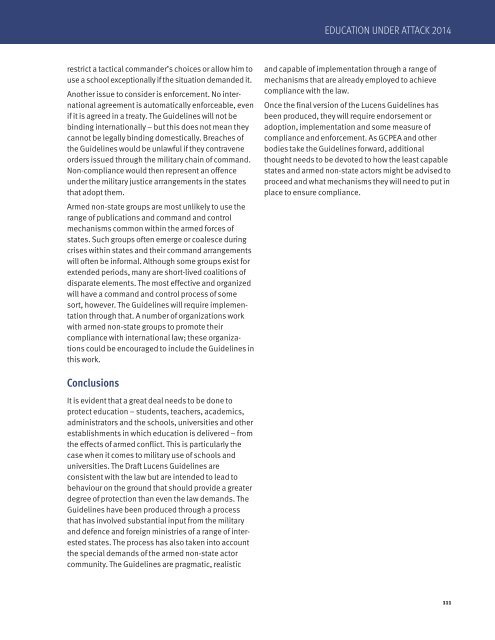Create successful ePaper yourself
Turn your PDF publications into a flip-book with our unique Google optimized e-Paper software.
EDUCATION UNDER ATTACK 2014<br />
restrict a tactical commander’s choices or allow him to<br />
use a school exceptionally if the situation demanded it.<br />
Another issue to consider is enforcement. No inter -<br />
national agreement is automatically enforceable, even<br />
if it is agreed in a treaty. The Guidelines will not be<br />
binding internationally – but this does not mean they<br />
cannot be legally binding domestically. Breaches of<br />
the Guidelines would be unlawful if they contravene<br />
orders issued through the military chain of command.<br />
Non-compliance would then represent an offence<br />
under the military justice arrangements in the states<br />
that adopt them.<br />
Armed non-state groups are most unlikely to use the<br />
range of publications and command and control<br />
mechanisms common within the armed forces of<br />
states. Such groups often emerge or coalesce during<br />
crises within states and their command arrangements<br />
will often be informal. Although some groups exist for<br />
extended periods, many are short-lived coalitions of<br />
disparate elements. The most effective and organized<br />
will have a command and control process of some<br />
sort, however. The Guidelines will require implementation<br />
through that. A number of organizations work<br />
with armed non-state groups to promote their<br />
compliance with international law; these organizations<br />
could be encouraged to include the Guidelines in<br />
this work.<br />
and capable of implementation through a range of<br />
mechanisms that are already employed to achieve<br />
compliance with the law.<br />
Once the final version of the Lucens Guidelines has<br />
been produced, they will require endorsement or<br />
adoption, implementation and some measure of<br />
compliance and enforcement. As GCPEA and other<br />
bodies take the Guidelines forward, additional<br />
thought needs to be devoted to how the least capable<br />
states and armed non-state actors might be advised to<br />
proceed and what mechanisms they will need to put in<br />
place to ensure compliance.<br />
Conclusions<br />
It is evident that a great deal needs to be done to<br />
protect education – students, teachers, academics,<br />
administrators and the schools, universities and other<br />
establishments in which education is delivered – from<br />
the effects of armed conflict. This is particularly the<br />
case when it comes to military use of schools and<br />
universities. The Draft Lucens Guidelines are<br />
consistent with the law but are intended to lead to<br />
behaviour on the ground that should provide a greater<br />
degree of protection than even the law demands. The<br />
Guidelines have been produced through a process<br />
that has involved substantial input from the military<br />
and defence and foreign ministries of a range of interested<br />
states. The process has also taken into account<br />
the special demands of the armed non-state actor<br />
community. The Guidelines are pragmatic, realistic<br />
111



